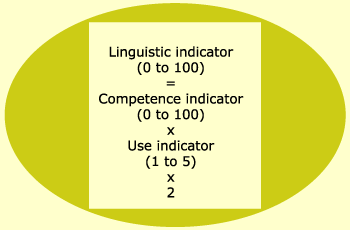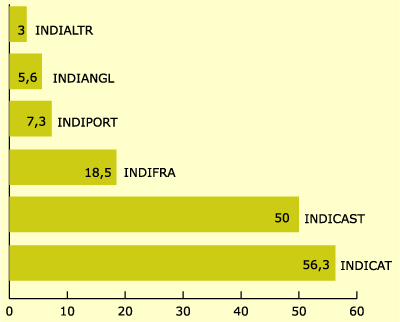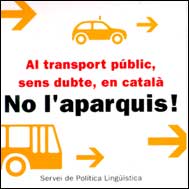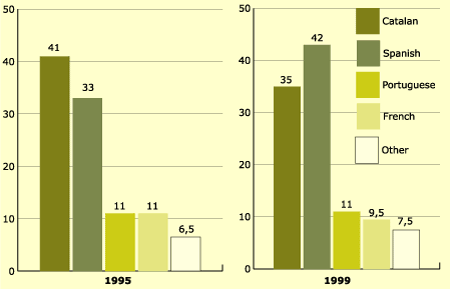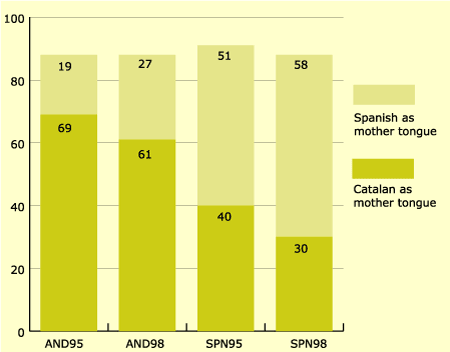
| Sociolingüística catalana |
| The studies carried out by the Andorran Administration as a point of reference for the language planning, by Marta Pujol i Montserrat Badia | ||||
| CONTINUA |
| 2.5 Linguistic index To obtain a synthesis of the level of knowledge and the frequency of use of each language, we measured the data on a scale ranging from 0 to 100, where 0 meant the inexistence of knowledge and use of Catalan and 100 a perfect knowledge of the language and a very high level of use of Catalan, by means of the implementation of a formula used to calculate the linguistic index. (1)
This first survey aroused much interest as it "officially" established for the first time the linguistic diversity of Andorrans and the fragility of the Catalan-speaking group, especially compared to the growing group of Spanish speakers. The data also showed that Andorra was opening itself more to the South from a cultural point of view so that the French cultural influence was decreasing (press, radio, television, university education). As already stated, the survey also pointed out the low use of Catalan in some sectors of the socio-economic domain. This was a cornerstone for the planning of the actions carried out by the government's language policy, given that after establishing the origin of members of the population and their degree of motivation to speak Catalan, this service decided to launch a general campaign with arguments and resources more suited to the reality of the Andorran linguistic situation. The campaign focused on the usefulness of speaking Catalan since this was considered a much more effective argument for people targeted by the campaign than other much more patriotic or sentimental reasons put forward in other campaigns. The campaign consisted of two parts. The first used hoarding showing messages such as: You use it to work, to buy and sell, to make friends, to play or to love. During this advertisement stage, thousands of forms were distributed in shops to ask people what this thing was that was useful for so many purposes. Customers were asked to chose between Catalan and four other possibilities and those who answered successfully could win a trip for two people to New York. The campaign managed to mobilise a lot of people and the result was considered satisfactory. Further to this campaign, the governmental actions focused on such sectors as public transport, bars and shopping centres, since the survey indicated lower use of Catalan in these settings. Preliminary reports were also issued prior to submitting a draft motion to the General Council.
It is clear, then, that sociolinguistic studies have been highly relevant in drawing up the main lines of Andorran language policy and can even be said to be the origin of the current linguistic legislation. In 1999 the language policy service commissioned another survey also based on a quantitative research, following the same working methodology and with the same target population as the 1995 survey: residents in Andorra aged 14 years and over. The objective was to gather information on the knowledge and linguistic uses of the population and to compare the results with those of 1995 in order to monitor the way the situation was evolving. The methodological details were as follows:
3.1 Mother tongue of the adult population of Andorra To understand the evolution since 1995 of the use of Catalan among the population of Andorra aged 14 and over, the most important finding to note is that Spanish is now the mother tongue or the first language of the majority of the population while Catalan is relegated to a second position:
In terms of nationalities, the main change is the significant increase in the number of Andorrans claiming Spanish as mother tongue (8.3 points) and the decrease (9.6 points) of Catalan-speaking Spaniards:
3.2 Linguistic use at home, with friends and at work
|
